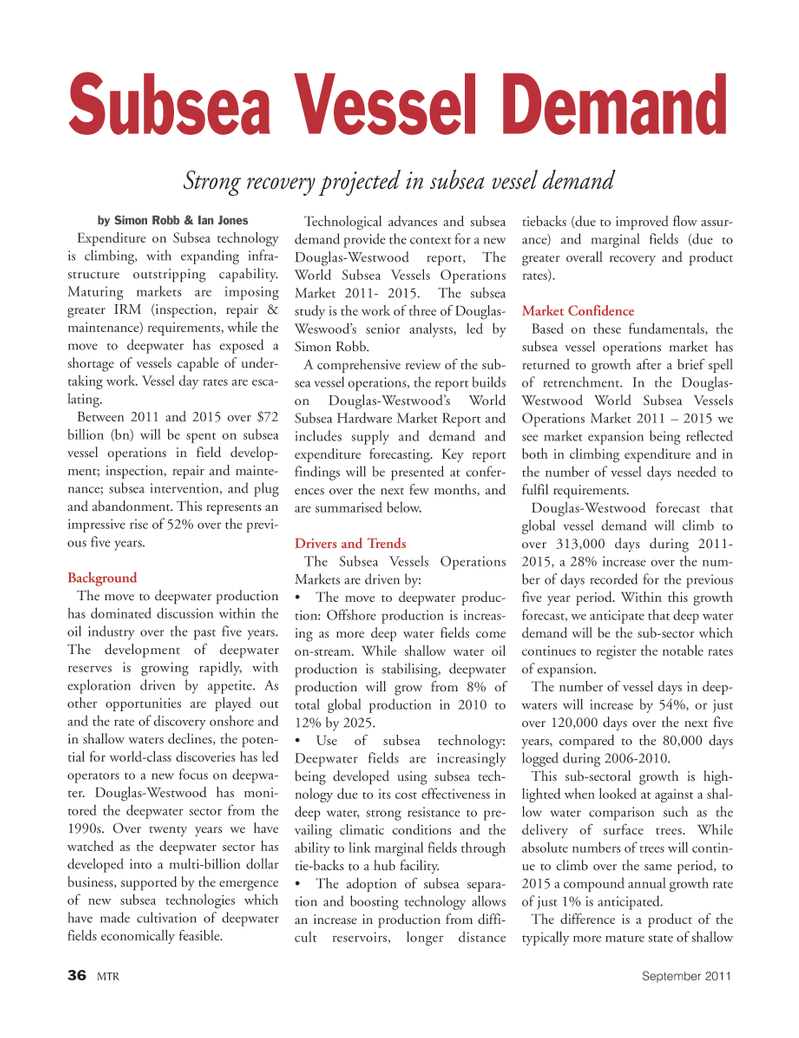
Page 36: of Marine Technology Magazine (September 2011)
Ocean Observation
Read this page in Pdf, Flash or Html5 edition of September 2011 Marine Technology Magazine
36MTRSeptember2011 Subsea Vessel Demand Strong recovery projected in subsea vessel demand by Simon Robb & Ian JonesExpenditure on Subsea technology is climbing, with expanding infra-structure outstripping capability. Maturing markets are imposing greater IRM (inspection, repair & maintenance) requirements, while the move to deepwater has exposed a shortage of vessels capable of under- taking work. Vessel day rates are esca- lating.Between 2011 and 2015 over $72 billion (bn) will be spent on subseavessel operations in field develop- ment; inspection, repair and mainte- nance; subsea intervention, and plug and abandonment. This represents an impressive rise of 52% over the previ- ous five years. Background The move to deepwater production has dominated discussion within theoil industry over the past five years. The development of deepwater reserves is growing rapidly, with exploration driven by appetite. As other opportunities are played out and the rate of discovery onshore and in shallow waters declines, the poten- tial for world-class discoveries has led operators to a new focus on deepwa- ter. Douglas-Westwood has moni- tored the deepwater sector from the 1990s. Over twenty years we have watched as the deepwater sector has developed into a multi-billion dollar business, supported by the emergence of new subsea technologies which have made cultivation of deepwater fields economically feasible. Technological advances and subsea demand provide the context for a new Douglas-Westwood report, The World Subsea Vessels Operations Market 2011- 2015. The subsea study is the work of three of Douglas- Weswood?s senior analysts, led by Simon Robb. A comprehensive review of the sub- sea vessel operations, the report builds on Douglas-Westwood?s World Subsea Hardware Market Report and includes supply and demand andexpenditure forecasting. Key report findings will be presented at confer- ences over the next few months, and are summarised below. Drivers and Trends The Subsea Vessels Operations Markets are driven by: The move to deepwater produc- tion: Offshore production is increas- ing as more deep water fields come on-stream. While shallow water oil production is stabilising, deepwater production will grow from 8% of total global production in 2010 to 12% by 2025. Use of subsea technology: Deepwater fields are increasingly being developed using subsea tech- nology due to its cost effectiveness in deep water, strong resistance to pre- vailing climatic conditions and the ability to link marginal fields through tie-backs to a hub facility. The adoption of subsea separa- tion and boosting technology allows an increase in production from diffi- cult reservoirs, longer distance tiebacks (due to improved flow assur- ance) and marginal fields (due togreater overall recovery and product rates). Market Confidence Based on these fundamentals, the subsea vessel operations market has returned to growth after a brief spell of retrenchment. In the Douglas- Westwood World Subsea Vessels Operations Market 2011 ? 2015 we see market expansion being reflected both in climbing expenditure and in the number of vessel days needed to fulfil requirements. Douglas-Westwood forecast that global vessel demand will climb to over 313,000 days during 2011- 2015, a 28% increase over the num- ber of days recorded for the previous five year period. Within this growth forecast, we anticipate that deep water demand will be the sub-sector whichcontinues to register the notable rates of expansion. The number of vessel days in deep- waters will increase by 54%, or just over 120,000 days over the next five years, compared to the 80,000 days logged during 2006-2010.This sub-sectoral growth is high- lighted when looked at against a shal-low water comparison such as the delivery of surface trees. While absolute numbers of trees will contin- ue to climb over the same period, to 2015 a compound annual growth rate of just 1% is anticipated. The difference is a product of the typically more mature state of shallow MTR#7 (34-48):MTR Layouts 8/29/2011 10:17 AM Page 36

 35
35

 37
37
